How many emails do you receive that start with, “Hi [mergetag]!”
Yes, email personalization like this is simple and easy to do if you have the right ESP. It’s become a popular tactic because we know email marketing personalization is good for business. 71% of consumers expect companies to deliver personalized experiences, according to McKinsey.
But if you want to send personalized email marketing campaigns that actually resonate with subscribers and help forge true connections, simply adding their first name to the subject line or greeting isn’t gonna cut it.
Real personalization looks like sending the right email at the right time to the right people.
Everyone has their unique path from awareness to conversion. The key to a good customer experience is understanding that journey and meeting each person with a consistent, yet tailored, email message at every opportunity.
That takes a lot of time, effort, and data that many email marketers don’t have. This is a sentiment many email marketers share.
In our new State of Email Innovations report, we asked email marketers about their biggest challenges to email personalization. Here’s what they told us: they either struggled to find the right data, didn’t have the resources to experiment with personalization techniques, or were intimidated by the technical how-to behind the scenes.
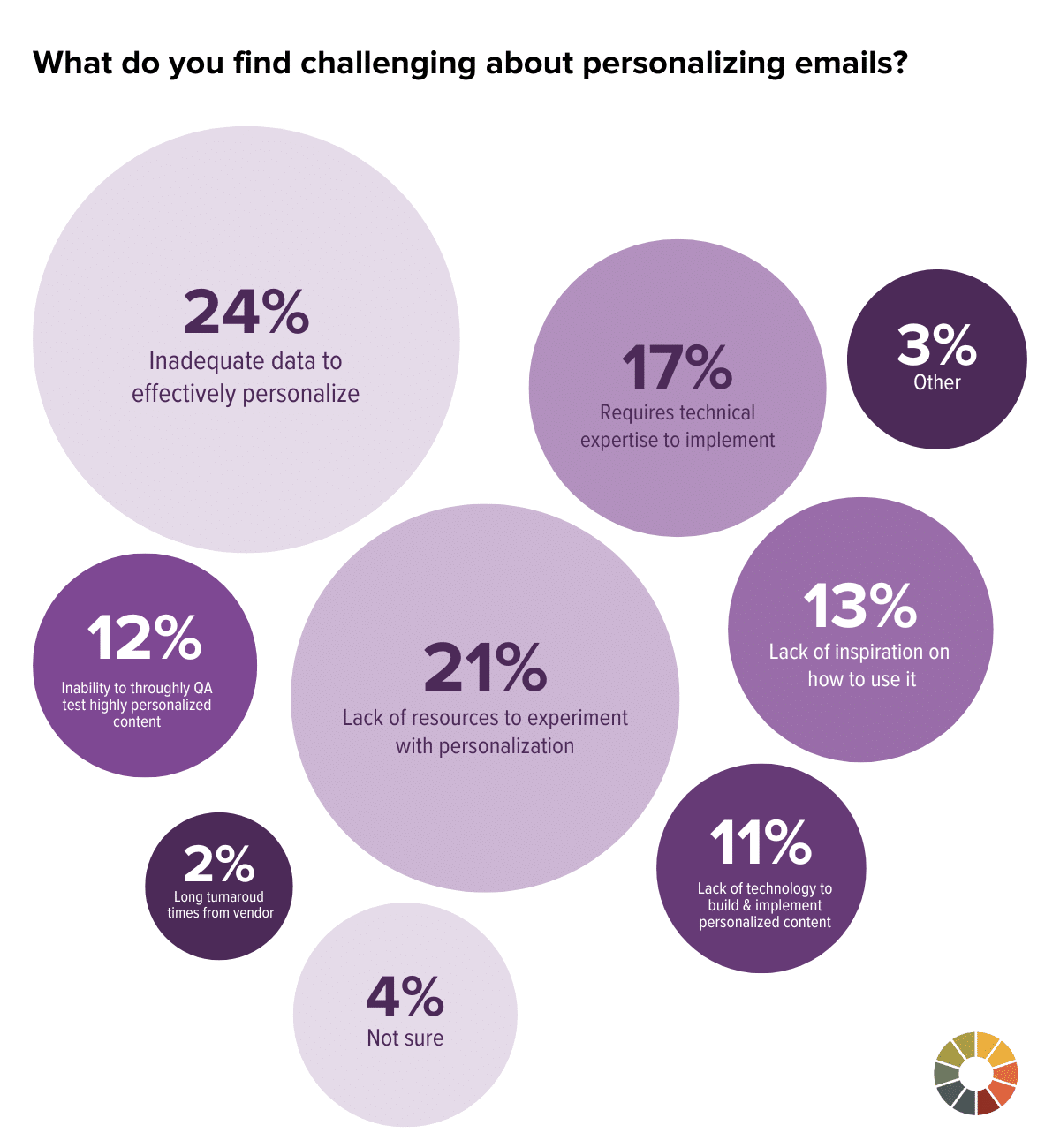
If you’re struggling to find the right data or resources to use for your personalization efforts, you’re not alone. But you can do a surprising amount of personalization without needing to build your own big data apparatus or storm the engineering department—here’s how you can enhance your email marketing personalization and meet your customers at every phase of their journey.
1. Embrace zero-party data for email personalization
Data makes the email personalization world go ‘round.
But a recent push for consumer privacy protection leaves marketers without third-party cookies at their disposal to plan and execute their email marketing personalization. In fact, an Epsilon study of US marketers found that 69% said the elimination of third-party cookies will have an even greater impact than GDPR and CCPA on their marketing efforts.
Between Google’s plan to end third-party cookies by 2025 and Apple Mail Privacy Protection, which hides subscribers’ IP addresses, it’s much more challenging to use traditional data sources to personalize your emails.
Guess what: you don’t actually need this data to send personalized emails that your subscribers love.
You have more data at your disposal than you think.
Here’s the data you really need for effective email marketing personalization as you plan your personalization strategy:
First-party data
First-party data is individual-level data that is collected directly from your audience on your own channels. Anything that you can track through your existing tech stack, from social media interactions to website and purchase behavior, counts as first-party data. This is the kind of data you can use to map out the customer journey based on behavior and engagement.
Second-party data
Second-party data is any data you can purchase from another company about your subscribers or customers. (And no, we still don’t advocate buying an email list!) Think more big-picture research and demographic data, like competitive analysis, broader consumer trends, or reviews from sites like Google or Tripadvisor. This can be useful to give your first-party data scale and context.
Zero-party data
Zero-party data is individual-level data explicitly given to you directly from your audience. This is data you already have about your subscribers and customers: things like names, addresses, company title, or other demographic data. But it also includes any information they volunteer to give you—all you have to do is ask.
It’s zero-party data that gives your email campaigns that personalization magic no one else can replicate. According to our 2021 State of Email report, 71% of consumers expressed frustration with impersonal experiences. This is your chance to get to know your subscribers on a 1:1 level and deliver on the promise of personalized emails.
If you make an effort to talk to your subscribers directly about their preferences on messages they want to see, topics they want to learn about, and how they want to interact with you, then you won’t be like every other email in their inbox. You can do this with fun, interactive content like this:
Or through a strong email preferences center from Going:
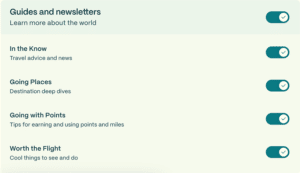
Source: Going
Applying these details strengthens your email marketing personalization strategy and allows you to deliver brand value and improve the customer experience.
2. Practice good data hygiene to keep your personalization current
Good data hygiene for email marketing is one of the most important steps to designing high-performing campaigns.
Having quality data that is accurate, current, trustworthy, and useful ensures your customers get the personalized experiences they want, and helps your business make informed data-driven decisions for your email marketing strategy.
Without regular data cleansing, your data can become stale—resulting in lower email engagement, poor deliverability, and ultimately, decreased ROI.
Knowing what data points to access, how to store and use consumer information, and ways to routinely “clean” your data can take your email marketing personalization to the next level.
To do this, understand your internal data supply chains such as the sources and destinations, the formats of dates, text fields, numbers, and the latency at which data is expected to arrive or transact between these different sources to reduce issues.
When we talked to email marketers about their personalization efforts, the majority relied on their ESP/MAP to handle their personalization efforts.
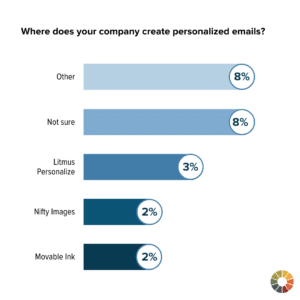
But your ESP is only one piece of the data puzzle.
You need to mine the data that’s across your entire organization to make personalized emails work for you. You may need to work with your sales, support, or engineering team to fully map out where all of your data is coming from and how to make it all “talk” to one another.
The more you can understand the various data sources available to you, the easier it will be to pull out the type of information that matters for your campaigns, like:
- Demographic information, like geography or birthday
- Where they opted in to receive your emails
- Topic preferences
- Email opens and clicks by topic or product
- Purchase history
- Website browsing
- Social media engagement
- Content downloads
- Sales or customer support interaction
- Responses to feedback surveys or Net Promoter Score
If you collect this data, put it to use. You don’t need every single piece of data to send great emails—start with one campaign at a time using zero-party or first-party data you already have.
Then, establish a governance model to control permissions in data tools and designate a power user for every data push. If you can, create a data dictionary to catalog what each piece of data means to your company and make it accessible.
Personalize email campaigns at every stage of the customer journey
Once your data is in order, you can create truly effective email marketing personalization with every send and make customers feel valued throughout their journey.
When it comes to execution, creating tailored messages can vary in sophistication. The majority of email marketers we surveyed (36%) use personalization in the subject line or preview text, which can encourage your subscribers to open your emails.
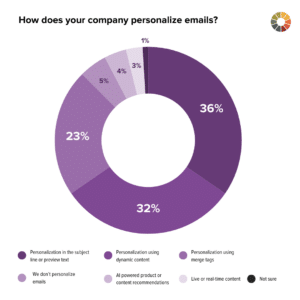
More advanced email marketing personalization like dynamic content was a popular choice as well at XX%. This includes product recommendations based on site behavior, cart abandonment, or special offers that can take your customer experience to the next level.
But our favorite kind of personalized content—the kind that really wows subscribers—is live or real-time content, which only 7% of respondents say they use. If you want to stand out in the inbox, it’s these tactics that are going to do it.
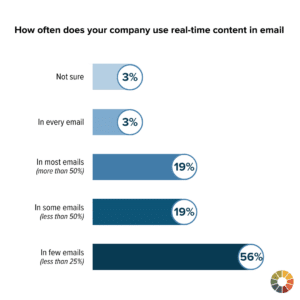
Don’t be intimidated by using live or real-time content. Live content can be as simple as using personalized images, or you can try one of these suggestions:
1. Countdown timers
For the senders using live content, countdown timers are the most popular choice. Countdown timers use email open times to display time left for sales, exclusive offers, or event registrations.
That’s because they add a sense of urgency and excitement to emails that is especially effective for big product launches or campaigns.
You don’t want to overuse a countdown timer for every sale. Stick with some of your biggest campaigns of the year, either as a pre-sale promo or to let subscribers know how long deals will (or won’t) last. Make sure you are transparent with your countdown timers. If you often extend sales, or are planning on extending a specific sale, don’t use a countdown timer as it will not be as effective.
2. Geolocation
Geolocation targeting based on CRM data is an easy way to add the kind of personalized details your subscribers appreciate, such as including the address for the closest brick-and-mortar stores or concert venues.
No one wants to get excited about an upcoming event in a subject line only to realize it’s hundreds of miles away. If you’re promoting an IRL event, segment your list based on geolocation.
3. Weather-based content
Using the weather in the subscribers’ location at the time of email open to trigger or change certain content can make a big difference for engagement. Take a typical seasonal campaign like this example, promoting the fall season:
And instead of it falling flat in places where it’s September and still 8,000 degrees outside (and certainly not sweater or PSL weather), you can adjust it to send just to folks experiencing a real fall, or edit it to talk about taking a trip to see fall foliage instead.
4. Interactive polling
Interactive polling allows recipients to see what is popular, and vote on what they like, which encourages continued engagement as recipients come back to see the results. This works for any kind of question you want to ask.
At Litmus, we use our own Personalize tool at the bottom of every monthly newsletter to see how our subscribers liked it. We use that feedback to help us build the next newsletter and inform our A/B testing strategy.
5. Social feed
Social signals showcase live interactions with a product or service (through the live number of “likes”) on social channels. You can take an email already focused on social proof, like this one:
And make it tuned-in to what subscribers are actually reading or watching in real-time. Adding a social element to emails encourages more people to click through, but does double duty promoting your social media channels and getting more engagement there, too.
Personalize your emails beyond the basics
Subscribers expect personalization in their inboxes. And it’s not just about names and subject lines anymore. Email personalization means data-driven dynamic and interactive content that serves custom experiences to your subscribers. That’s where the right data is so essential.
Knowing how to collect and clean accurate and timely customer data to tailor your personalization strategy lets you engage with audiences intentionally and effectively every time.
The post Email Personalization: How to Find Better Data appeared first on Litmus.
https://www.litmus.com/blog/email-marketing-personalization-using-data